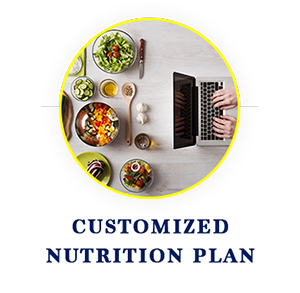In addition to helping us be the best we can be, eating a balanced diet is extremely important for slowing down the effects of aging and disease. There are several categories I will touch on that I feel are the most important aspects to creating and maintaining a meal plan that will make you much stronger, leaner and help you age gracefully. Keep in mind these are guidelines for a normal healthy adult and in no way should be taken over the advise of your physician, dietician or other healthcare provider. This is for informational purposes to give clients an idea of what I do to stay in shape.
Fitness Nutritional Tips
If trying to lose weight, be sure to eat 10% calories less than your maintenance calories. This will help minimize the amount of muscle tissue lost and will be a safe and slow way to lose weight. Another thing to keep in mind is to fluctuate your daily calories, one day higher another day lower, but have a weekly goal total. Remember, the faster you lose weight, the more muscle you lose and lean muscle drives your metabolism! A good rule of thumb when trying to plan, is by eating foods that are not calorie dense. Divide the total calories of the food by the total weight of the food (in grams). If the result is .8 or greater, it’s a calorie dense food.
For example, lets take a 100 grams of broccoli. 100 grams of broccoli has 35 calories. 35/ 100= .35- this is not a calorie dense food. We can contrast this with peanuts. In 100 grams of peanuts there is 575 calories. 575/100= 5.75!!! Obviously this is a very high calorie food but it occupies the same amount of volume or space in your stomach. In general foods high in fiber and moisture like vegetables and fruits are far less calorie dense even though they weigh the same as their dryer calorie dense counter parts.
There are ways you can “roughly” calculate your caloric expenditure and determine how many calories you need to be consuming a day to lose, maintain or gain weight. Take your body weight in Kilograms and multiple it by 24. Then determine your energy expenditure by multiplying that number by .10 (Sedentary)- .20 (Moderately active) or .30 (Heavily activity). Combine the two and that is roughly how many calories a day you burn to maintain your current weight. There are other ways to get a more precise number but this is a good starting point that can be moved up or down depending on age, lean body weight, activity level and male vs female.
The formula below is another good daily caloric estimator:
The calorie calculations are a rough estimate or starting point and should be adjusted to lose only 1-2 lbs per week.
Sedentary – No exercise and you sit at work all day.
Lightly Active – No exercise but you are very active at work or walk a lot.
Moderately Active – Job has some work and you exercise 3 hours or less a week.
Very Active – Active at work and you workout 6-9 hours a week.
Extremely Active – Involved in a highly active competitive sport.
Another thing to keep in mind is to be sure you’re consuming the right amounts of protein, carbohydrates and fats. To determine this value your total calories should consist of the following percentages according to what your exercise goals are:
HEALTHY
- 1.2 g/Kg/BW- PROTEIN
- 55% CARBO
- 30% FAT
ENDURANCE
- 1.4 g/Kg/BW – PROTEIN
- 65% CARBO
- 20% FAT
RESISTANCE
- 1.8 g/Kg/BW – PROTEIN
- 55% CARBO
- 25% FAT
It’s important to eat protein with every meal. This will prevent your body from eating muscle tissue and will ensure you have enough available at all times to repair muscle tissue and keep your system functioning at its best. It will also help you feel full longer because it takes more time to digest. Note: 1/3 of the calories in a gram of protein are used up during the digestion of it. This is mostly where the term “Thermic effect” of food comes from. It is a good idea when following a resistance program to include more protein in your diet. About 1.6- 1.8 grams per pound of body weight. NOTE: Most dietitians and nutritionists will not agree but, in the body building community the rule of thumb is (1) gram per pound of body weight. This advise comes from the respected physician Carlon M Colker, MD, FACN who authored the book “Extreme Muscle Enhancement”. I myself agree with Mr. Colker (See food quality for examples of the types protein recommended)
Be sure not to go more than 3 hours without food and try to have your largest meals early in the day or before the busiest part in your daily schedule. Eating every three hours helps keep your metabolism running high. Not eating this way will slow your body down because it wants to conserve energy. The total calories should then be spaced out over three meals and two snacks.
NOTE: Intermittent fasting is a new “Fad” diet that has several variations. The most common format used is to eat during an eight hour window and fast the remaining sixteen hours. For example, your last meal is at 6:00pm. The dieter wouldn’t eat until 12:00pm the next day. It works for some and not for others. I suggest doing your research if it sounds like something you are interested in. Intermittent fasting supposedly helps the body “clean itself up” through a process called Autophagy.
This is a crucial meal to eat and is the best time for nutrient absorption. Your body is rushing to replace the things it needs, like proteins, fats and carbohydrates. So it’s called the “Window of opportunity”. This is the only time I advocate separating your carbs and proteins. Protein is digested in an acidic environment and carbs in an alkaline environment. Eat the proteins and fats first with your fats. Then wait 30 mins and eat your carbs. Eating a whey protein protein drink shortly after the workout will help provide the body with fast digesting complete proteins to help rebuild the muscle you just broke down. That is why some people advocate whey protein drinks after workouts. In addition, growth hormone is secreted during and after workouts. If you eat carbs too soon after the workout, you will not be able to take advantage of the growth hormone produced because insulin will deactivate it. Insulin is the dominant hormone because it regulates blood glucose which has priority over every hormone.
The glycemic index is a good guideline to follow for carbohydrates, which is explained, in the next bullet point-Food Quality. I believe sugar is probably the biggest culprit for sabotaging a persons weight loss success; however after a workout the body wants to replenish your muscles stores of sugar (Glycogen). It can do that fast with simple sugars via insulin, the most anabolic hormone in the human body. Insulin is secreted in response to elevated blood glucose (sugar) to help maintain sugar homeostasis or balance. Once insulin is done replacing muscle glycogen extra calories are stored as fat. So any other time you eat excess sugar all you are doing is creating a FAT storing machine.
“Simple” Sugar and refined carbohydrates should be avoided. When it comes to carbs, choose foods that are a “complex” carbohydrates and not “simple”. Simple and complex carbs are defined by their given Glycemic Index number (GI):Note: There are many people in the physique world and other sports like CrossFit who incorporate what is called “Carb cycling”. One day a person eats 150 grams another day 100 grams and 75 grams on another day. The point of this is to keep your body guessing and it also makes low carb diets easier to deal with because there are higher carb days. Many people believe keeping carbs under 100 grams a day helps them maintain or lose weight. It’s definitely something that can be looked into and requires research before starting.
The Glycemic index (GI)- indicates how fast a food is converted into sugar. Too much Simple sugar denatures the receptor sites for most of our metabolic hormones like insulin. Too much sugar can cause insulin resistance, which can cause the body to secrete more because it becomes insufficient. The more insulin that floats around the less efficient it becomes. This can lead to diabetes.
The following is a breakdown of the glycemic index. A number below 55 is considered a Complex carbohydrate. Above 55 is considered a Simple sugar.
The Glycemic Index broken down:
| Low GI | =55< |
| Medium GI | =55>69 |
| High GI | = 70 or more (you can find this at any health food store or online) |
The glycemic index can be found by doing a Google search.
The Glycemic load- is also important, which is how much sugar is in a serving. The glycemic load has become an equally important statistic as the glycemic index. The glycemic index is used to predict glycemic load. Glycemic index (x) the total grams of carbs per serving. Divide that number by 100. A number from 1-10 is considered low. 11-19 is moderate and over 20 is high. Always shoot low.
What are Net Carbs? Taking the total grams of carbs in a food and subtracting the fiber content will determine net carbs. Most people like to count net carbs because they believe dietary fiber does not affect blood sugar and our bodies can’t pull calories from them. This statement holds true to insoluble but not soluble fibers. So a good rule of thumb when counting net carbs is to determine which ones are soluble and insoluble. Fiber choices are explained more in depth below.
What are “Sugar Alcohols”? They are artificial sweeteners added to foods. Many are not digestible and have fewer calories than carbs, which is why they are used. It’s easy to tell which foods have them because they will usually list the term “net carbs” in the ingredients list. Some common names are glycerol, erythritol, maltitol, sorbitol, xylitol and lactitol. Basically any ingredient that ends in an “ol”. Each one listed above has different properties that determine which type of foods they are best used in. What makes these undesirable is that they can cause cramping and a host of other digestive issues and other indirect dysfunctions. Why are they not recommended? Most of these sweeteners are excreted in our urine, which in turn increases the frequency of urination. The increase in urination causes a loss of crucial minerals such as calcium, magnesium and potassium. All these are related to cramping. Magnesium however is vital for muscle relaxation as well as many other vital processes. If we can’t get muscles to relax they become stiff and rigid over time and lend themselves to stiff and sore joints.
Other important food quality aspects are:
- No bread or white flower. Unless it’s sourdough, pumpernickel or Ezekiel.
- No fried foods.
- Limited Saturated fats- however, an occasional steak, butter or cream is acceptable. These are a much better choice- avocado’s, walnuts, almonds, egg yolk, olives, flaxseed, hemp seed and chia seeds. Be sure to eat a variety of proteins like chicken, turkey, lean beef like a filet and different cold water fish like salmon and trout.
- Eliminate all vegetable oils (used in any way) and select the following instead. Olive oil, avocado oil, peanut oil and coconut oil.
Note: Do not cook with olive due to its low smoke point, which is the point or temperature at which it begins to “smoke”. This is a concern because at this point it not only becomes harmful but also dangerous. Once oil begins to smoke, it is getting close to its “flash point” and could catch fire and ignite the gasses it’s giving off. That’s why olive oil is best used on salads and other cold foods. It does not mean they can’t be used to cook with, just use extra caution. The term “virgin” olive oil is common. What this refers to is at what point the oil is stored after processing it by crushing nuts and seeds or pressing olives in this case. The faster it can be stored the better. If it’s stored rather quickly it is referred to as “virgin”. You can guess then what “Extra virgin” and these other adjectives mean. Stored even faster.
Additional info:
- No Trans Fat– it’s usually in many fast foods and processed meats. When you see “hydrogenated” or “partially hydrogenated” oils on an ingredient list, the food contains trans fats. Trans-fat can raise (LDL) cholesterol and increase the risk of heart disease. The same goes for vegetable oil, which denatures the coding on lipid molecules making it harder for the cell to identify. NOTE: Sugar does this as well. That’s why more and more cardiologist are having patients, that are experiencing elevated cholesterol levels, refrain from sugar and other high glycemic carbs. High fructose corn syrup is a huge culprit. It’s a manufactured sugar that is in most processed foods and drinks today.
- High fructose corn syrup or (HFCS) is a manufactured form of sugar or corn syrup that consists of glucose and fructose in an “unbound” relationship. This unbound relationship is not like other sugar molecules that are bound and require digestion, like the fructose in fruit, which also contains glucose. Since fructose is sweeter than glucose, the corn industry chemically changed the corn syrup molecule by converting some of the glucose into fructose which makes HFCS sweeter than regular corn syrup. This form of sugar (HFCS) is much cheaper to produce as well. What’s unsettling is that the production of HFCS is proprietary and the process of how it is made remains unknown. The fructose portion of HFSC bypasses digestion and goes straight to the liver where it converts the fructose into fat, making HFSC a major contributor to fatty liver. In addition, this fructose does not signal insulin secretion to lower blood sugar and causes us to continue eating because the hunger mechanism is not regulated properly and we take longer to feel full. Since we continue to eat, the glucose portion of HFSC requires insulin to lower blood levels. When the fat cell becomes saturated with glucose it converts the glucose into fructose inside the cell. The higher concentrations of fructose in the cell can be dangerous. So the body turns off accepting more glucose from insulin and the individual becomes insulin resistant. Subsequently, more and more glucose will be left circulating in the blood and become a major contributor of diabetes.
Eat a variety of proteins, fish, turkey, eggs and lean meats. Lentils are high in protein and excellent when combined with BROWN rice as well as peas and many other beans.
- Eat as many green vegetables as you wish and choose other “colors” as well. Keep in mind vegetables that grow in the ground like carrots, beats, potatoes and parsnips have more calories per serving than most vegetables that grow out of the ground.
- Make your meat and dairy grass fed and antibiotic free. A personal favorite of mine is Greek yogurt. Also, if you’re lactose intolerant a good substitute for milk is almond milk. A brand called “Silk” is excellent and the unsweetened version only has 35 calories per serving. Note- if you are lactose intolerant whipping cream and fermented cheeses like Parmesan have next to no lactose in them from the fermenting process. Studies are also finding that many people are not lactose intolerant but having trouble digesting milk. They have discovered that there are two forms of milk protein. A1 & A2. A1 is common these days and people are having trouble digesting it. The symptoms are similar to lactose intolerance. Many people may be avoiding dairy when they really need the A2 protein version. Again, do your research to see where you can get it and if you may have this intolerance.
- Consume fruits consisting of a low glycemic index. I believe focusing on berries is best. For more variety these are good as well- apples, kiwi, cherries, grapefruit, oranges, peaches & plums.
- Eat whole grains and not white flower. For example- Eat brown rice not white and have wheat pasta instead of regular. Also, it’s better to eat what are called “sprouted grains”. It’s a process in which the grain is soaked in water and then removed so it can sprout or germinate. Lectin is a plants protective mechanism to help keep insects away so it can eventually germinate or sprout under the right temperature and moisture conditions. When humans eat lectins, they can irritate the digestive tract and cause things like leaky gut. Sprouting can be done at home but it is a tricky process and if not done right can be harmful.
- Instead of cereal select oatmeal (Old Fashioned) or cream of wheat.
I always recommend not salting your food and to be aware of food labels and how much sodium is in the product. Daily sodium intake for normal healthy adults should be below 1500mgs a day which is about 3/4 of a teaspoon per day or a gram weight of 3.75. There are approximately 9 different types of salt. I like to use Himalayan pink salt. It tastes cleaner and has 84 essential minerals your body requires. It can reduce muscle cramping and spasms, promote blood sugar health and also help to promote a healthy PH within the cells.
It is very important to drink approximately 1 oz. per kilogram of body weight (89kg =195lbs / 89 ounces a day) spread out evenly throughout the day. It will not only keep you healthy and hydrated but it will also aid in fat loss. When the kidneys don’t get enough water they work harder and don’t function at their best. The liver is forced to work harder to help out and “puts aside” its less important tasks, like burning fat for energy. Instead it will use more carbohydrates, which is easier to use than fat and much more is stored in the muscles than the liver.
One more important water fact. Try not to drink too much with a meal because it will dilute the digestive enzymes. Have it about 10 minutes before a meal or 45 minutes after. NOTE: for athletes or people sweating a lot be sure to drink a 7% or less carbohydrate solution using glucose polymers. This will help absorption during extensive sweating. That is about 55-65 calories per 8 ounces or 236 milliliters.
Fibers are the structural parts of plants. Most are complex carbohydrates. Fibers can also be classified according to their solubility in water. Two types of fibers include soluble and insoluble. In general, water-soluble fibers dissolve in hot water and occur in high concentrations in fruits, whole grains, oats, barley, legumes, and some vegetables; water insoluble fibers are found in higher concentrations in vegetables, wheat, and cereals. It is important to include both types of fiber in your diet. Water-soluble fibers delay the stomach’s emptying and the transit of chyme through the intestines. They have also been shown to lower blood cholesterol levels. Water insoluble fibers accelerate the transit time of chyme and increase fecal weight. In the body, both types of fiber slow starch breakdown and delay glucose absorption into the blood. Most healthy adults require approx. 21-40 grams of fiber a day.
Many people have a need or desire to eat late at night before bed. I am a firm believer in not eating carbohydrates at least 4 hours before going to bed. That means any carbohydrate other than green leafy vegetables or other low calorie vegetables i.e., hearts of palm, artichokes, tomatoes, onions and string beans. I also feel competitive athletes or other persons striving to obtain a low level of body fat and who are on a calorie restricted diet, should consume about (2) oz. of lean meat protein right before bed. Turkey is best for it’s L-tryptophan content, which helps us fall asleep. This form of protein will provide the body with a “time released” version of amino acids while you are sleeping, which is 8 hours without food. This is a good habit to minimize muscle breakdown and keep hunger at bay. To re-iterate, I believe in doing this only when the individual is on a calorie-restricted diet. So be sure your not eating a lot of junk or empty calories late night.
I am not a big believer in taking vitamins if you are healthy and under 40 years of age. Vitamins are needed in small amounts and minerals even less. Some vitamins, if taken in excess, such as Vitamins A, D, and E & K are harmful to the liver. Too much Vit B6 (More than 600mg/day) can cause loss of sensation in peripheral nerves. Too much Vit D can cause excessive Calcium deposits.
There are two kinds vitamins, water soluble and fat-soluble. Fat-soluble are stored in our bodies adipose tissue so they are easier to overuse and become dangerous, especially to organs like the liver. As we age our digestive systems are not as efficient due to aging, poor diets, antibiotics, prescription drugs, alcohol and other environmental factors. So supplements, if taken wisely under a knowledgeable professional, can be a good addition, especially a good protein supplement or bar. If you are one of those people that must eat on the run, it’s important to remember, protein supplements ARE NOT meant to be meal replacements and only to be used as a supplement to your regular diet. If you have a poor diet or have been advised to by a Nutritionist, Dietician or Physician or you are involved in a vigorous exercise program, I believe supplements have their place and can be a good addition to a healthy lifestyle.
More below on supplements.
AS ALWAYS CHECK WITH YOUR DOCTOR BEFORE TAKING ANYTHING, ESPECIALLY IF YOUR HAVING SURGERY or PREGNANT!!!!! Supplements are not regulated so many times you are not getting what is reported on the label in product strength, contents or quality. The following recommendations are for informational purposes and in no way should be adopted or applied unless discussed with your physician.
Supplement RULES: SERIOUS BUSINESS.
1) ALWAYS, check with your doctor or other healthcare provider before taking any supplements: See a D.O. (Doctor of Osteopathic Medicine)
2) May interfere with Surgeries, Medications, or other procedures. For example:
- Fish oil & gingko biloba- inhibit Clotting.
- Grapefruit- can endanger a person taking medication because it blocks the enzyme your body uses to break down certain drugs. In turn the body can reach toxic levels of the medication. Not just grapefruit but other citrus fruits like limes and others. The medication list is long but involves cholesterol meds, anti anxiety drugs, blood pressure meds and ones that fight infections to name a few.
3) Be careful not to “Double Dip”- Extra accidently taken- i.e. two supplements have the same thing in it.
4) Be sure to read labels for food and other allergies you may have.
5) Be sure to follow the dosage instructions on the labels.
6) As I mentioned earlier, the supplement industry is not regulated. So it is a good idea to check the reliability or quality of the supplement you want to invest in by going to the following web site- https://www.consumerlab.com. There you can learn about products, testing results, warnings, where to buy it, reviews and the latest news as well.
METHODS OF APPLICATION:
-Rubbed on
-Orally
-Sublingual
-Injected
-inhaled
TYPES:
-Pro-hormones- Precursors for actual hormones, i.e. Mark McGuire-Adrostennedione
-Anti-oxidant’s- prevents cell membrane oxidation. Cut open an apple and squeeze a lemon on it. You can see the antioxidants at work preserving it.
-Vitamins- Water-soluble & fat-soluble.
-Minerals- Usually metals like zinc, copper, iron etc.
-Herbs- Plant sources in which many drugs are made from i.e. The salicin in willow bark converts to salicylic acid which is what aspirin is made from.
BOOKS:
Herbalism, Nutrition almanac, Deep nutrition, Sports Nutrition.
The supplements below are currently used by the medical community and have proven health benefits.
* Co Q10- Heart health, helps create energy. Must be taken if you are on statin drugs such as cholesterol lowering meds.
* Vitamin & Mineral- Food based, no “Mega formulas”. Usually for pre-natal. NOTE: If you suffer from hives or other food allergies, food based versions may be a culprit. Switch to non-food based.
* Vitamin D3- Bones, immune system.
* Omega 3 (DHA / EPA) – Mental health, heart and inflammation and also thins the blood.
* Trans resveratrol – Knotweed and Red wine. Good for anti aging.
* Turmeric-(Curcumin)- Gives mustard it’s yellow color. This is a CO2 inhibitor like Ibuprophen for inflammation. It’s natural though.
* Magnesium- Help relax muscles and most Americans are deficient. –sublingual Magnesium Citrate is my favorite or a powdered version called- Calm.
* Probiotics- Heal intestinal dysbiosis as well as fermented foods (Immune system)
CUSTOM
PLANS

LIMIT
PLATEAUS

PROVEN
RESULTS

EASY 2
UNDERSTAND

Are you?
Customized Plans
Do you have a specific goal or you just want to take it to another level











